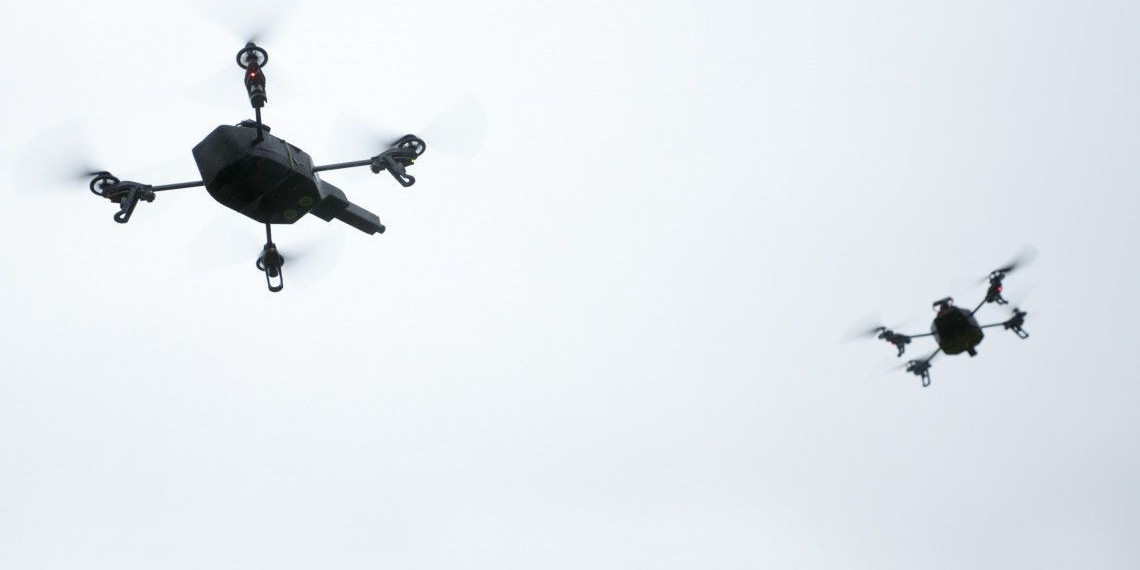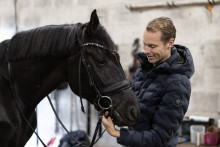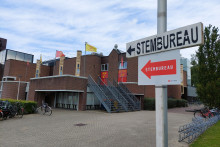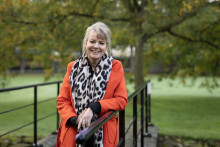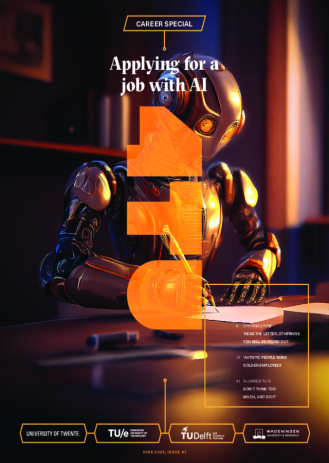‘Now that we are investing heavily in our security – and that of Europe – it’s good news for the defence industry. And Twente has that industry right in its backyard. Just as UT and Saxion educate people for research and development, to eventually deliver the best equipment for our armed forces and the entire chain that supports it.’
These are the words of outgoing Prime Minister Dick Schoof, spoken last September during the Opening of the Academic Year. A veiled call to strengthen ties with defence, set against a backdrop of geopolitical tensions and economic opportunities.
Schoof is not alone in this call. Consider this pair of articles: Defence is open to collaboration with higher education and Knowledge sector willing to support defence. Last summer, the Dutch government committed to NATO’s 5 percent norm, allocating 3.5 percent of GDP to the armed forces and 1.5 percent to defence-related matters such as infrastructure and cybersecurity. This was under pressure from the United States, in response to well-known Russian aggression and the resulting threat to Europe.
A turning point
How tempting the lure from defence will be, and whether UT researchers will respond en masse, remains to be seen. What is clear is that defence funding is increasing, as noted by UT’s Strategic Business Development (SBD) department. Impact development managers Nastassia Vilfan and Marleen Kuipers are well aware that research funding follows political and economic developments. ‘We act as quartermasters, helping to translate external developments into internal opportunities and the funding mechanisms that go with them. We try to bring those to researchers’, says Kuipers. ‘We identify and present opportunities. It’s up to the researcher to decide how they want to contribute to this part of society.’
Just over a year ago, Kuipers and Vilfan noticed a shift in the defence landscape: after more than two decades of budget cuts, doors are opening again. At the European level, the European Defence Fund offers a €7 billion programme. Recently, the Dutch Research Council (NWO) launched a call for ‘high-performance materials for defence and security’. In other words, research funding is starting to flow – albeit slowly for now.
‘A common misconception is to see the defence domain as just bombs, grenades, bullets and soldiers’ – Nastassia Vilfan
Last summer, SBD conducted a survey at UT to gauge interest among researchers in security and defence-related research. ‘About 15 percent of our principal investigators want to contribute to national and European security’, Vilfan reports. ‘That’s quite a lot.’ But she adds an important nuance. ‘The domain is extremely broad. It includes everything from human behaviour, health and governance to digital security, high-tech systems, critical infrastructures and the materials they’re made of. A common misconception is to see the defence domain as just bombs, grenades, bullets and soldiers. For us as a university, the core lies in strengthening the resilience of people, technology and society.’
Defending democracy
‘Defend democracy, collaborate with the defence industry’, wrote associate professor Hans Voordijk last year. This was in response to another opinion piece in U-Today that urged not to collaborate with defence or the arms industry. ‘No, I’m absolutely not in favour of war’, Voordijk says. ‘But we must be realistic: Putin is a psychopath, albeit with brilliant psychological insight. He poses a real threat to our freedom and democracy.’
And that freedom and democracy must be protected. Also by universities, Voordijk argues, who – like Vilfan – points to ‘persistent misconceptions’. He raised these during a recent Studium Generale debate on the topic. ‘The proposition was that the university should not contribute to research on bombs and grenades. But today we face different kinds of warfare, with direct threats to our democracy and infrastructure, such as disinformation or cyberattacks. Just look at last August, when Russian hackers opened the floodgates of a Norwegian dam.’
Catching up
Within this theme, UT professor of cybersecurity Roland van Rijswijk-Deij is now involved in a research project to protect offshore wind turbines. ‘We’re heading towards an energy capacity of 21 gigawatts at sea. Knowing that the furthest parks are over a hundred kilometres offshore, you have to rely on electronic control. If that’s disabled or sabotaged, the consequences could be enormous. We need to protect the infrastructure 365 days a year – an attacker only needs one successful attempt. Robust digital security is therefore crucial’, says the professor.
A clear defence issue, one might say. Yet the project is funded through a different channel: the top sector energy. ‘Everyone agrees the topic is important, that’s not the issue. As a society, we struggle with how to secure critical infrastructure and who is responsible for it.’
According to the professor, another factor is the shift Defence had to make after years of budget cuts. Not long ago, soldiers had to shout ‘bang bang!’ during exercises due to ammunition shortages. ‘Defence is now catching up after years of neglect and cuts. The organisation may still be adjusting to this new reality.’ Marleen Kuipers from Strategic Business Development agrees. ‘It’s a major transition for such an organisation, both in terms of threat levels and the capacity and investments required.’
A different rhythm
What would actual collaboration between universities and ‘defence’ look like? Someone familiar with both worlds is Tiedo Tinga, UT part-time professor of Dynamics Based Maintenance – also affiliated with the Netherlands Defence Academy. ‘A key point is knowing the right entry points and trying to build a sustainable relationship.’ That’s a complex task in itself, he knows. ‘It’s a huge organisation that is quite opaque. So it’s difficult for universities to make contacts, build networks and identify where the needs lie. An added complication is that people in military positions rotate every three years.’
‘Defence wants something deployable within six months. As a researcher, you need to think carefully about that’ – Tiedo Tinga
What makes it even harder, according to Tinga, is that the organisations don’t necessarily operate at the same pace. ‘There’s a lot of urgency at Defence now: it has to be short-term and deliver concrete results. Those are precisely the things that are not easy for us as a university. We tend to focus on the long term, conceptually and with a low technology readiness level. Defence prefers something deployable within six months. As a researcher, you need to think carefully about that. Maybe collaboration with the surrounding industry is more feasible – if you want to get involved. Defence is often the end user.’



Roland van Rijswijk-Deij, Hans Voordijk and Tiedo Tinga.
Openness and academic freedom
All interviewees also point to a difference in working culture between universities and ‘defence’. Universities are built on openness and international collaboration, while security research sometimes requires discretion. ‘Open really means open – people don’t always realise that’, says Vilfan. ‘Our scientific publications are public. That can clash with the interests of other parties, especially when it involves sensitive technology.’
That’s not always the case, Voordijk adds. Besides being an associate professor, he is programme manager of the Joint Innovation Center TNO-UT, focused on digital lifecycle management. ‘Within this framework, we look at strengthening physical infrastructure such as bridges and roads. That certainly relates to enhancing Dutch resilience, but it’s very different from TNO’s defence-related work behind closed doors. In such cases, the openness of publications – which is so normal for us – can indeed conflict with academic freedom. If you enter into such a collaboration, you need to think carefully about how to structure it.’
A balancing act
It raises plenty of dilemmas: any collaboration with a defence-related party brings questions about academic freedom, knowledge security and ethics. Technology intended for innocent purposes can be used for harmful ones. Everyday chips have found their way into Iranian killer drones. Conversely, military technology has led to civilian applications, such as GPS, meteorology, the internet and sanitary pads.
‘The reality is that our national security is no longer a given’ – Roland van Rijswijk-Deij
It’s the well-known dual-use dilemma for researchers. ‘It’s very hard to predict where your research will end up’, Voordijk observes. ‘In hindsight, almost everyone who worked on drones, GPS or AI in recent decades has contributed to weapons development.’ What researchers need are guidelines. ‘It’s good that we’ll soon have a UT-wide committee for sensitive collaborations‘, Van Rijswijk summarises. ‘There will always be grey areas. Whether the committee says yes or no, you’ll at least know it was carefully considered.’
He acknowledges the ethical concerns and uses his academic freedom to make his own choices. ‘Speaking for myself: I have no issue with collaborating with Dutch defence, or – by extension – European defence, or companies clearly working to improve societal security. Let’s continue to disagree internally – the more careful and thorough our decisions will be. The reality is that our national security is no longer a given. As a university, we are part of society, so we are also responsible for protecting it.’


